Pricing Guides & Dictionary of Makers Marks for Antiques & Collectibles

A few examples of appraisal values for
UNIVERSITY OF MICHIGAN
Search our price guide for your own treasures
-
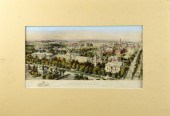 Richard Rummell Hand Colored Litho.
Richard Rummell Hand Colored Litho. of UniversityA Hand colored antique lithograph by Richard Rummell(1848-1944) depicting a panaramic view of the Universityof Michigan campus as it was in the early 20th century 7.25''H X 14''W unframed and under matting. Condition: With light staining and slight foxing.
Richard Rummell Hand Colored Litho.
Richard Rummell Hand Colored Litho. of UniversityA Hand colored antique lithograph by Richard Rummell(1848-1944) depicting a panaramic view of the Universityof Michigan campus as it was in the early 20th century 7.25''H X 14''W unframed and under matting. Condition: With light staining and slight foxing. -
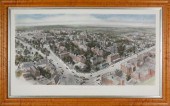 RICHARD RUMMELL LITHOGRAPH OF
RICHARD RUMMELL LITHOGRAPH OF "HARVARD UNIVERSITY"Richard Rummell (1848-1924) Lithograph of "Harvard University" , signed lower right Richard Rummell, in molded tiger maple frame with silver gilt liner Overall 21 in. x 33.5 in. Condition: Items may have wear and tear, imperfections or the effects of aging. Please contact the gallery for further details prior to bidding. Any condition statement given as a courtesy should not be treated as fact.
RICHARD RUMMELL LITHOGRAPH OF
RICHARD RUMMELL LITHOGRAPH OF "HARVARD UNIVERSITY"Richard Rummell (1848-1924) Lithograph of "Harvard University" , signed lower right Richard Rummell, in molded tiger maple frame with silver gilt liner Overall 21 in. x 33.5 in. Condition: Items may have wear and tear, imperfections or the effects of aging. Please contact the gallery for further details prior to bidding. Any condition statement given as a courtesy should not be treated as fact. -
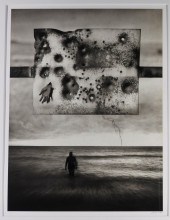 JERRY UELSMANN PLATINUM PORTFOLIO
JERRY UELSMANN PLATINUM PORTFOLIO PHOTOGRAPH Michigan,b.1934Untitled (Metal Plate), from the Platinum Portfolio, silver gelatin print, edition 25 of 25, 1990.
JERRY UELSMANN PLATINUM PORTFOLIO
JERRY UELSMANN PLATINUM PORTFOLIO PHOTOGRAPH Michigan,b.1934Untitled (Metal Plate), from the Platinum Portfolio, silver gelatin print, edition 25 of 25, 1990. -
 (VIEW) MICHIGAN: 100 POSTCARDS
(VIEW) MICHIGAN: 100 POSTCARDS EARLY TO MID-20TH CENTURY(VIEW) MICHIGAN: 100 POSTCARDS, Early to Mid-20th Century, Real photo: Lake City street scene (40's-50's), early Waldron St. scene, street scene (Sandusky), DU frat (Ann Arbor), Main St. (Alcona), salt piles (Morton Salt Co.), Maral's Lumber Co., mill, Mowery's cocktail lounge with one-armed woman bartender, lumber jack's picnic (Edenville), x-ray exam at Sanitarium (Battle Creek), '48 "Hidden Valley - home of Otsepo (?) Ski Club", Belle Isle Bridge fire (4/27/1915), Diamond House Grounds, two printed House of David cards (one with band), "Toonerville Trolly (sic)", Camp Margrethe Trailer Camp and more. Early: Parke, Davis & Co. laboratories employees packaging medicinal ampoules, "1,000 chassis, A Day's Output at the Ford Motor Company", State Prison (Jackson), Silvertone of Coldwater street scene, cage of men about to be lowered into mine (Wakefield), Center St. (Bay City), Postum Cereal Roasting Dept., State Penitentiary scene, Detroit of Ste. Claire Flats resort, Leightons of So. Main St. and State St. from campus (Ann Arbor), "Bay Furnace", "Scene on Cottage Row, State Public School" (Coldwater), spruce log, Lansing St. scene, packing room at Kellogg Company. This is a must-see lot for Michigan postcard collectors!.
(VIEW) MICHIGAN: 100 POSTCARDS
(VIEW) MICHIGAN: 100 POSTCARDS EARLY TO MID-20TH CENTURY(VIEW) MICHIGAN: 100 POSTCARDS, Early to Mid-20th Century, Real photo: Lake City street scene (40's-50's), early Waldron St. scene, street scene (Sandusky), DU frat (Ann Arbor), Main St. (Alcona), salt piles (Morton Salt Co.), Maral's Lumber Co., mill, Mowery's cocktail lounge with one-armed woman bartender, lumber jack's picnic (Edenville), x-ray exam at Sanitarium (Battle Creek), '48 "Hidden Valley - home of Otsepo (?) Ski Club", Belle Isle Bridge fire (4/27/1915), Diamond House Grounds, two printed House of David cards (one with band), "Toonerville Trolly (sic)", Camp Margrethe Trailer Camp and more. Early: Parke, Davis & Co. laboratories employees packaging medicinal ampoules, "1,000 chassis, A Day's Output at the Ford Motor Company", State Prison (Jackson), Silvertone of Coldwater street scene, cage of men about to be lowered into mine (Wakefield), Center St. (Bay City), Postum Cereal Roasting Dept., State Penitentiary scene, Detroit of Ste. Claire Flats resort, Leightons of So. Main St. and State St. from campus (Ann Arbor), "Bay Furnace", "Scene on Cottage Row, State Public School" (Coldwater), spruce log, Lansing St. scene, packing room at Kellogg Company. This is a must-see lot for Michigan postcard collectors!. -
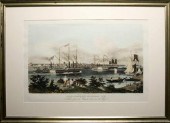 William Bennett CITY OF DETROIT,
William Bennett CITY OF DETROIT, MICHIGAN, 1837 Color photoreproduction Estimate:$100-$150
William Bennett CITY OF DETROIT,
William Bennett CITY OF DETROIT, MICHIGAN, 1837 Color photoreproduction Estimate:$100-$150 -
 Ann Arbor, Michigan painting,
Ann Arbor, Michigan painting, landscape with lake and boats, signed lower left "Mrs. Zschuckelt" and inscribed verso "Ms. Frieda Zschuckelt/1127 E. Ann Str./Ann Arbor, Mich.", oil on Masonite, 15-7/8 x 19-5/8 in.; painted wood frame. Minor flaking lower left, light grime.
Ann Arbor, Michigan painting,
Ann Arbor, Michigan painting, landscape with lake and boats, signed lower left "Mrs. Zschuckelt" and inscribed verso "Ms. Frieda Zschuckelt/1127 E. Ann Str./Ann Arbor, Mich.", oil on Masonite, 15-7/8 x 19-5/8 in.; painted wood frame. Minor flaking lower left, light grime. -
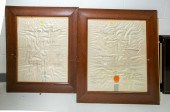 TWO FRAMED DIPLOMAS University of
TWO FRAMED DIPLOMAS University of Maryland Medical School, Baltimore, 1853 and 1900.
TWO FRAMED DIPLOMAS University of
TWO FRAMED DIPLOMAS University of Maryland Medical School, Baltimore, 1853 and 1900. -
 19TH C. AMERICAN SCHOOL "SUNRISE ON
19TH C. AMERICAN SCHOOL "SUNRISE ON LAKE MICHIGAN""Sunrise on Lake Michigan" Oil on Canvas. Signed lower left. Inscribed verso (Study from Nature Chicago 1880). Sight Size: 12 x 8 in. Overall Framed Size: 13.75 x 9.75 in. Condition: - By registering to bid for this auction either in-house or online and/or placing a bid in this auction the BIDDER/BUYER agrees to all the terms and conditions of Helmuth Stone Gallery Auctions. - Due to the size of our gallery not all items are out for preview at one time. If you plan on coming to preview any lot(s) we recommend letting us know prior so we can have them collected and prepared for your preview. - All silver, gold and/or jewelry lots or invoices containing said lots MUST be paid for via WIRE TRANSFER, no other forms of payment will be accepted. - All items are sold as-is where-is and no guarantees are made of any kind. All sales are final; no refunds will be given under any circumstances. - All artwork is listed and sold per section (10) of our terms and conditions, please read over all definitions of authorship prior to bidding to better understand artwork listings. - Helmuth Stone Gallery provides condition reports as a courtesy to our clients and assumes no liability for any error or omission. Any condition statement is given as a courtesy to a client and is only an opinion and should not be treated as a statement of fact. Descriptions are our opinions and should in no way be construed as a guarantee of any kind as to age, condition, mater. The bidder assumes responsibility for ensuring that the condition of the item(s) meets with their satisfaction prior to bidding. The absence of a condition statement does not imply that the lot is in perfect condition or completely free from wear and tear, imperfections, or the effects of aging. - Online images can sometimes be low quality due to the uploading process, original high-resolution images can be requested via email at HelmuthStone@gmail.com - We recommend looking into shipping quotes prior to bidding, shipping quotes can take up to a week or more post-sale as we host our auctions through multiple online platforms and shipping can become backlogged, if you would like a list of local shippers please email us directly. - Our auction catalogs are hosted through multiple online platforms along with phone and in-house bidding. Bids placed on other platforms are not shown through this catalog. Because of this, even if it appears you are the only absentee bid or bidder on a lot, you may already be outbid or may have placed a bid equal to another bidder. Therefore, we always recommend bidding live. - Unless otherwise stated in the description, all items are sold without additional documentation or COAs. If any supporting documentation is available an image will be available online via the catalog listing.
19TH C. AMERICAN SCHOOL "SUNRISE ON
19TH C. AMERICAN SCHOOL "SUNRISE ON LAKE MICHIGAN""Sunrise on Lake Michigan" Oil on Canvas. Signed lower left. Inscribed verso (Study from Nature Chicago 1880). Sight Size: 12 x 8 in. Overall Framed Size: 13.75 x 9.75 in. Condition: - By registering to bid for this auction either in-house or online and/or placing a bid in this auction the BIDDER/BUYER agrees to all the terms and conditions of Helmuth Stone Gallery Auctions. - Due to the size of our gallery not all items are out for preview at one time. If you plan on coming to preview any lot(s) we recommend letting us know prior so we can have them collected and prepared for your preview. - All silver, gold and/or jewelry lots or invoices containing said lots MUST be paid for via WIRE TRANSFER, no other forms of payment will be accepted. - All items are sold as-is where-is and no guarantees are made of any kind. All sales are final; no refunds will be given under any circumstances. - All artwork is listed and sold per section (10) of our terms and conditions, please read over all definitions of authorship prior to bidding to better understand artwork listings. - Helmuth Stone Gallery provides condition reports as a courtesy to our clients and assumes no liability for any error or omission. Any condition statement is given as a courtesy to a client and is only an opinion and should not be treated as a statement of fact. Descriptions are our opinions and should in no way be construed as a guarantee of any kind as to age, condition, mater. The bidder assumes responsibility for ensuring that the condition of the item(s) meets with their satisfaction prior to bidding. The absence of a condition statement does not imply that the lot is in perfect condition or completely free from wear and tear, imperfections, or the effects of aging. - Online images can sometimes be low quality due to the uploading process, original high-resolution images can be requested via email at HelmuthStone@gmail.com - We recommend looking into shipping quotes prior to bidding, shipping quotes can take up to a week or more post-sale as we host our auctions through multiple online platforms and shipping can become backlogged, if you would like a list of local shippers please email us directly. - Our auction catalogs are hosted through multiple online platforms along with phone and in-house bidding. Bids placed on other platforms are not shown through this catalog. Because of this, even if it appears you are the only absentee bid or bidder on a lot, you may already be outbid or may have placed a bid equal to another bidder. Therefore, we always recommend bidding live. - Unless otherwise stated in the description, all items are sold without additional documentation or COAs. If any supporting documentation is available an image will be available online via the catalog listing. -
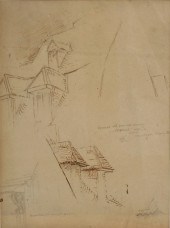 INK DRAWING - Architectural Studies
INK DRAWING - Architectural Studies from the Canadian Notebooks of Architect Stanford White (1853-1906) of the famous firm of McKim Mead & White with his monogram and notation 'Dormers old French house opposite called Montcalm Manor' and 'Bracket next d
INK DRAWING - Architectural Studies
INK DRAWING - Architectural Studies from the Canadian Notebooks of Architect Stanford White (1853-1906) of the famous firm of McKim Mead & White with his monogram and notation 'Dormers old French house opposite called Montcalm Manor' and 'Bracket next d -
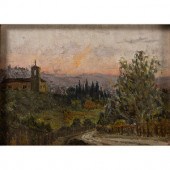 American School, 20th Century
American School, 20th Century unsigned 5 7/8 x 8 1/4 inches. Property from the Estate of Julia W. Bishop, East Lansing, Michigan
American School, 20th Century
American School, 20th Century unsigned 5 7/8 x 8 1/4 inches. Property from the Estate of Julia W. Bishop, East Lansing, Michigan -
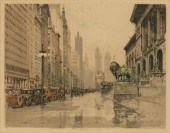 LUIGI KASIMIR, (1881-1962), THE
LUIGI KASIMIR, (1881-1962), THE LIONS OF MICHIGAN AVENUE, ETCHING AND AQUATINT IN COLORS ON PAPER, IMAGE: 13.5" H X 17.5" W; PLATE: 14.Luigi Kasimir, (1881-1962) The lions of Michigan avenue Etching and aquatint in colors on paper From the edition of unknown size and date Signed in pencil just inside the platemark at lower center: Luigi Kasimir Image: 13.5" H x 17.5" W; Plate: 14.125" H x 18" W Etching and aquatint in colors on paper Dimensions: Image: 13.5" H x 17.5" W; Plate: 14.125" H x 18" W
LUIGI KASIMIR, (1881-1962), THE
LUIGI KASIMIR, (1881-1962), THE LIONS OF MICHIGAN AVENUE, ETCHING AND AQUATINT IN COLORS ON PAPER, IMAGE: 13.5" H X 17.5" W; PLATE: 14.Luigi Kasimir, (1881-1962) The lions of Michigan avenue Etching and aquatint in colors on paper From the edition of unknown size and date Signed in pencil just inside the platemark at lower center: Luigi Kasimir Image: 13.5" H x 17.5" W; Plate: 14.125" H x 18" W Etching and aquatint in colors on paper Dimensions: Image: 13.5" H x 17.5" W; Plate: 14.125" H x 18" W -
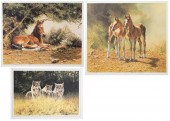 BONNIE MARRIS (MICHIGAN, BORN 1951)
BONNIE MARRIS (MICHIGAN, BORN 1951) THREE OFFSET LITHOGRAPHSBONNIE MARRIS (Michigan, born 1951) three offset lithographs: "Best Friends," "Mom's Shadow," and "Other Footsteps." Each signed, edition 482/850, 283/1000, and 697/950, images measure from 8.25" x 12" to 16.5" x 21", unframed, in original folios.
BONNIE MARRIS (MICHIGAN, BORN 1951)
BONNIE MARRIS (MICHIGAN, BORN 1951) THREE OFFSET LITHOGRAPHSBONNIE MARRIS (Michigan, born 1951) three offset lithographs: "Best Friends," "Mom's Shadow," and "Other Footsteps." Each signed, edition 482/850, 283/1000, and 697/950, images measure from 8.25" x 12" to 16.5" x 21", unframed, in original folios. -
 RICHARD RUMMELL PRINT OF UVARichard
RICHARD RUMMELL PRINT OF UVARichard Rummell (1848-1924) print of the University of Virginia, hand colored with a Remarque in the lower margin and signed in the plate. Matted and framed. Measures approximately 25-5/8" in height by 37-5/8" in width with sight image of approximately 15-3/8" in height by 28-3/16" in width. Some foxing to print. Richard Rummell created a series of hand engraved copper printing plates depicting a panoramic aerial perspective of some of the nation's most prestigious colleges and universities.
RICHARD RUMMELL PRINT OF UVARichard
RICHARD RUMMELL PRINT OF UVARichard Rummell (1848-1924) print of the University of Virginia, hand colored with a Remarque in the lower margin and signed in the plate. Matted and framed. Measures approximately 25-5/8" in height by 37-5/8" in width with sight image of approximately 15-3/8" in height by 28-3/16" in width. Some foxing to print. Richard Rummell created a series of hand engraved copper printing plates depicting a panoramic aerial perspective of some of the nation's most prestigious colleges and universities. -
 Allegorical Academic pediment
Allegorical Academic pediment illustration/mural study for University?; knowledge/education theme with gothic architecture and fleur de lis crests; early 20th Century; graphite and watercolor on paper. 6 1/2"H x 22"W. Artist unknown. Custom matted and framed under glass.
Allegorical Academic pediment
Allegorical Academic pediment illustration/mural study for University?; knowledge/education theme with gothic architecture and fleur de lis crests; early 20th Century; graphite and watercolor on paper. 6 1/2"H x 22"W. Artist unknown. Custom matted and framed under glass. -
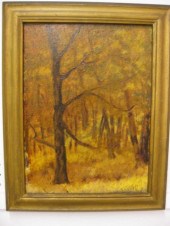 Maxine E. Hutcheson Oil ''Summer in
Maxine E. Hutcheson Oil ''Summer in Michigan'' exhibited at Art Club of St. Petersburg Fl circa 1930 image area 12'' x 16'' on studio board.
Maxine E. Hutcheson Oil ''Summer in
Maxine E. Hutcheson Oil ''Summer in Michigan'' exhibited at Art Club of St. Petersburg Fl circa 1930 image area 12'' x 16'' on studio board. -
 CORNELL UNIVERSITY,
CORNELL UNIVERSITY, CHROMOLITHOGRAPH, FRAMED, 19 X 31 INCHESCornell University, Chromolithograph, Framed, 19 x 31 inches
CORNELL UNIVERSITY,
CORNELL UNIVERSITY, CHROMOLITHOGRAPH, FRAMED, 19 X 31 INCHESCornell University, Chromolithograph, Framed, 19 x 31 inches -
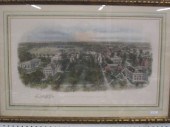 Richard Rummell Lithograph
Richard Rummell Lithograph ''University of NorthCarolina'' carved & gilt frame image area 30'' x 18''.
Richard Rummell Lithograph
Richard Rummell Lithograph ''University of NorthCarolina'' carved & gilt frame image area 30'' x 18''. -
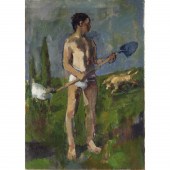 AMERICAN ACADEMIC SCHOOL, SEMI NUDE
AMERICAN ACADEMIC SCHOOL, SEMI NUDE MALE PORTRAIT American Academic School (Mid/Late 20th c.), Young Man Holding Shovel, oil on canvas, unsigned, 28"h x 20"w (canvas), unframed
AMERICAN ACADEMIC SCHOOL, SEMI NUDE
AMERICAN ACADEMIC SCHOOL, SEMI NUDE MALE PORTRAIT American Academic School (Mid/Late 20th c.), Young Man Holding Shovel, oil on canvas, unsigned, 28"h x 20"w (canvas), unframed -
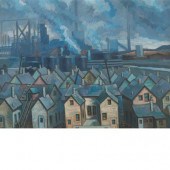 Elmer Lakatos 20th Century
Elmer Lakatos 20th Century Industrial Detroit Estimate:$800-$1,200
Elmer Lakatos 20th Century
Elmer Lakatos 20th Century Industrial Detroit Estimate:$800-$1,200 -
 FRANK LIVINGSTON FITHIAN (NJ,
FRANK LIVINGSTON FITHIAN (NJ, 1865-1935) Students on Green in front of Princeton University Building, ca 1918 illustration mixed media on thin board, signed lower right, unframed, in foamcore folio, 19" x 23".
FRANK LIVINGSTON FITHIAN (NJ,
FRANK LIVINGSTON FITHIAN (NJ, 1865-1935) Students on Green in front of Princeton University Building, ca 1918 illustration mixed media on thin board, signed lower right, unframed, in foamcore folio, 19" x 23". -
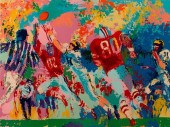 LEROY NEIMAN / RIVALRY
LEROY NEIMAN / RIVALRY (1973)LeRoy Neiman (American, 1921-2012) Rivalry (Michigan and Ohio State) , 1973 Serigraph on paper 21" x 28" An artist's proof from the Ohio State Buckeye suite, pencil-signed and numbered (A.P. XX/L) to the bottom margin. Presented behind glass in a yellow metal frame that measures 31" x 37". Provenance : From the art collection of a former University of Michigan starting football player, from the 1969 team that famously upset Ohio State in Bo Schembechler's first season as head coach. Condition Very good condition. Not removed from the frame.
LEROY NEIMAN / RIVALRY
LEROY NEIMAN / RIVALRY (1973)LeRoy Neiman (American, 1921-2012) Rivalry (Michigan and Ohio State) , 1973 Serigraph on paper 21" x 28" An artist's proof from the Ohio State Buckeye suite, pencil-signed and numbered (A.P. XX/L) to the bottom margin. Presented behind glass in a yellow metal frame that measures 31" x 37". Provenance : From the art collection of a former University of Michigan starting football player, from the 1969 team that famously upset Ohio State in Bo Schembechler's first season as head coach. Condition Very good condition. Not removed from the frame. -
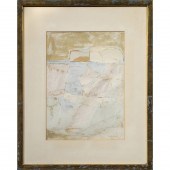 COLLAGE, MICHELLE STUART Michelle
COLLAGE, MICHELLE STUART Michelle Stuart (American, b. 1940), "The Frost," 1958, pigment and rag paper collage, signed, titled, and dated lower right, sight: 14"h x 10"w, overall (with frame): 22.25"h x 17.5"w
COLLAGE, MICHELLE STUART Michelle
COLLAGE, MICHELLE STUART Michelle Stuart (American, b. 1940), "The Frost," 1958, pigment and rag paper collage, signed, titled, and dated lower right, sight: 14"h x 10"w, overall (with frame): 22.25"h x 17.5"w -
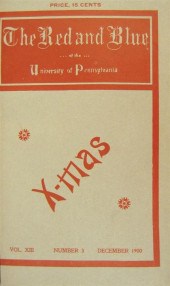 1 vol. (Periodical Literature.)
1 vol. (Periodical Literature.) The Red and Blue of The University of Pennsylvania. (Philadelphia), Dec., 1900 - June, 1901, Oct., 1901 - Feb., 1902. 4to, contemp. red morocco & blue cloth; rubbed. 12 issues bound in 1 vol., orig. pictorial wrappers bound in. Photo, other illus., adverts. Clean.
1 vol. (Periodical Literature.)
1 vol. (Periodical Literature.) The Red and Blue of The University of Pennsylvania. (Philadelphia), Dec., 1900 - June, 1901, Oct., 1901 - Feb., 1902. 4to, contemp. red morocco & blue cloth; rubbed. 12 issues bound in 1 vol., orig. pictorial wrappers bound in. Photo, other illus., adverts. Clean. -
 1 vol. McMaster, John Bach;
1 vol. McMaster, John Bach; Geyelin, H. Laussat. The University of Pennsylvania Illustrated and a Sketch of Franklin Field. Philadelphia: J.B. Lippincott, 1897. Oblong 4to, orig. two-tone cloth, gilt; slightly scuffed, some edge wear, spine ends & corners slightly frayed. Double-page plan, full-page half-tone photo views, other views. Adverts.
1 vol. McMaster, John Bach;
1 vol. McMaster, John Bach; Geyelin, H. Laussat. The University of Pennsylvania Illustrated and a Sketch of Franklin Field. Philadelphia: J.B. Lippincott, 1897. Oblong 4to, orig. two-tone cloth, gilt; slightly scuffed, some edge wear, spine ends & corners slightly frayed. Double-page plan, full-page half-tone photo views, other views. Adverts. -
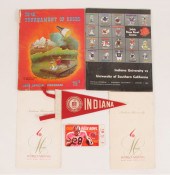 Lot of memorabilia: Indiana
Lot of memorabilia: Indiana University pennant, IU vs U of SC Rose Bowl program with ticket, two IU World Airways menus, and a 79th Tournament of Roses program from 1968.
Lot of memorabilia: Indiana
Lot of memorabilia: Indiana University pennant, IU vs U of SC Rose Bowl program with ticket, two IU World Airways menus, and a 79th Tournament of Roses program from 1968. -
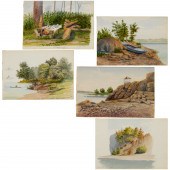 AMERICAN SCHOOL, (5) WATERCOLORS
AMERICAN SCHOOL, (5) WATERCOLORS American School (19th c.), Landscapes incl. Michigan and Minnesota, watercolor on wove paper, some with dates, no signatures, three double-sided, hinged into mats. pencil notes on front of some mats, 7"h x 10"w (sheets), 21.75"h x 16"w (mats)
AMERICAN SCHOOL, (5) WATERCOLORS
AMERICAN SCHOOL, (5) WATERCOLORS American School (19th c.), Landscapes incl. Michigan and Minnesota, watercolor on wove paper, some with dates, no signatures, three double-sided, hinged into mats. pencil notes on front of some mats, 7"h x 10"w (sheets), 21.75"h x 16"w (mats) -
 PHOTO: THOMPSON PHOTO CO. "THIRTEEN
PHOTO: THOMPSON PHOTO CO. "THIRTEEN HUNDRED UNDERGRADUATES OF YALE COLLEGE", COPYRIGHT 1915, POUGHKEEPSIE, NY, PANORAMIC PHOTOGRAPH, BLACK AND WHITE IMAGE, STUDENT ASSEMBLY WITH PART OF CAMPUS GREEN VISIBLE BEYOND, FR...PHOTO: Thompson Photo Co. "Thirteen Hundred Undergraduates of Yale College", copyright 1915, Poughkeepsie, NY, panoramic photograph, black and white image, student assembly with part of campus green visible beyond, framed, wear consistent with age, some creases, small tears, discolorations, sold as is, ss: 7" h. x 58" l.
PHOTO: THOMPSON PHOTO CO. "THIRTEEN
PHOTO: THOMPSON PHOTO CO. "THIRTEEN HUNDRED UNDERGRADUATES OF YALE COLLEGE", COPYRIGHT 1915, POUGHKEEPSIE, NY, PANORAMIC PHOTOGRAPH, BLACK AND WHITE IMAGE, STUDENT ASSEMBLY WITH PART OF CAMPUS GREEN VISIBLE BEYOND, FR...PHOTO: Thompson Photo Co. "Thirteen Hundred Undergraduates of Yale College", copyright 1915, Poughkeepsie, NY, panoramic photograph, black and white image, student assembly with part of campus green visible beyond, framed, wear consistent with age, some creases, small tears, discolorations, sold as is, ss: 7" h. x 58" l. -
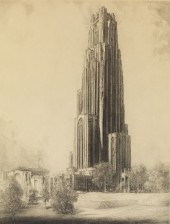 LOUIS ORR (AMERICAN, 1879 - 1961)
LOUIS ORR (AMERICAN, 1879 - 1961) 17½" x 13¼" image "Cathedral of Learning", 1937. Etching, depicting the Cathedral of Learning at University of Pittsburgh, pencil signed lower right, from an edition of 200 (no. 160) presented to University benefactors with label to verso, matted and framed, 27¼" x 22¾" overall. Provenance: Daniel M. Fawcett Estate private collection, Pittsburgh, PA.
LOUIS ORR (AMERICAN, 1879 - 1961)
LOUIS ORR (AMERICAN, 1879 - 1961) 17½" x 13¼" image "Cathedral of Learning", 1937. Etching, depicting the Cathedral of Learning at University of Pittsburgh, pencil signed lower right, from an edition of 200 (no. 160) presented to University benefactors with label to verso, matted and framed, 27¼" x 22¾" overall. Provenance: Daniel M. Fawcett Estate private collection, Pittsburgh, PA. -
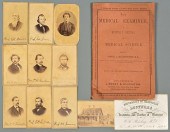 UNIV. OF NASHVILLE MED SCHOOL
UNIV. OF NASHVILLE MED SCHOOL ARCHIVEUniversity of Nashville Medical School faculty photographic archive. Includes CDVs labeled as Prof. J.B. (John Berrien) Lindsley, Dr. V.S. Lindsley, Prof. T.R. Jennings, John W. Hanner, Jr., Prof. Joseph Jones, Rev. S.D. Baldwin D.D. (T.S. Saltsman, Nashville, photographer label verso), Dr. T.B. Buchanan (includes what appears to be his autograph, verso), and Prof. C.K. Winston, along with an unidentified CDV of a young man (Charles C. Giers, Nashville, photographer label verso), and a CDV of a two story gabled house with figures, horse and buggy outside. Also included is a University of Nashville Lecture card with the signatures of W.K. Bowling and Mr. W.M. Noel (dated 1852). A photocopy from the University of Nashville Medical Department Catalog of 1865-66 identifies Jones, Bowling, Jennings, both Lindsleys, Winston, and Buchanan as 7 of the 9 faculty members of the school. Also included is an 1856 copy of THE MEDICAL EXAMINER: A MONTHLY RECORD OF MEDICAL SCIENCE, ed. by Samuel Hollingsworth, M.D. published Lindsay & Blakiston, Philadelphia. Note: John Berrien Lindsley organized the Medical Department of the University of Nashville, was elected Chancellor, and established Montgomery Bell Academy. Joseph Jones was also quite prominent: by the time he joined the University of Nashville faculty, he had worked as a Confederate Surgeon and conducted investigations into medical problems in the army of Northern Virginia and Tennessee and among prisoners of war at Andersonville. His Civil War experience led to his noteworthy research on Malaria and other infectious diseases. He went on to work at Tulane University School of Medicine and was president of the Board of Health of Louisiana and Surgeon General of the United Confederate Veterans (research material on Jones included). Condition: Some toning and foxing to CDVs, light stains, wear and small losses to medical journal.
UNIV. OF NASHVILLE MED SCHOOL
UNIV. OF NASHVILLE MED SCHOOL ARCHIVEUniversity of Nashville Medical School faculty photographic archive. Includes CDVs labeled as Prof. J.B. (John Berrien) Lindsley, Dr. V.S. Lindsley, Prof. T.R. Jennings, John W. Hanner, Jr., Prof. Joseph Jones, Rev. S.D. Baldwin D.D. (T.S. Saltsman, Nashville, photographer label verso), Dr. T.B. Buchanan (includes what appears to be his autograph, verso), and Prof. C.K. Winston, along with an unidentified CDV of a young man (Charles C. Giers, Nashville, photographer label verso), and a CDV of a two story gabled house with figures, horse and buggy outside. Also included is a University of Nashville Lecture card with the signatures of W.K. Bowling and Mr. W.M. Noel (dated 1852). A photocopy from the University of Nashville Medical Department Catalog of 1865-66 identifies Jones, Bowling, Jennings, both Lindsleys, Winston, and Buchanan as 7 of the 9 faculty members of the school. Also included is an 1856 copy of THE MEDICAL EXAMINER: A MONTHLY RECORD OF MEDICAL SCIENCE, ed. by Samuel Hollingsworth, M.D. published Lindsay & Blakiston, Philadelphia. Note: John Berrien Lindsley organized the Medical Department of the University of Nashville, was elected Chancellor, and established Montgomery Bell Academy. Joseph Jones was also quite prominent: by the time he joined the University of Nashville faculty, he had worked as a Confederate Surgeon and conducted investigations into medical problems in the army of Northern Virginia and Tennessee and among prisoners of war at Andersonville. His Civil War experience led to his noteworthy research on Malaria and other infectious diseases. He went on to work at Tulane University School of Medicine and was president of the Board of Health of Louisiana and Surgeon General of the United Confederate Veterans (research material on Jones included). Condition: Some toning and foxing to CDVs, light stains, wear and small losses to medical journal. -
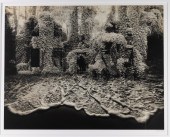 JERRY UELSMANN PLATINUM PORTFOLIO
JERRY UELSMANN PLATINUM PORTFOLIO KUDZU PHOTOGRAPH Michigan,b.1934Kudzu, from the Platinum Portfolio, edition of 25, 1982. Silver gelatin print of overgrown architectural ruins blended onto a sandy shore with low tide.
JERRY UELSMANN PLATINUM PORTFOLIO
JERRY UELSMANN PLATINUM PORTFOLIO KUDZU PHOTOGRAPH Michigan,b.1934Kudzu, from the Platinum Portfolio, edition of 25, 1982. Silver gelatin print of overgrown architectural ruins blended onto a sandy shore with low tide. -
 WIDE PANORAMA PHOTOGRAPH OF
WIDE PANORAMA PHOTOGRAPH OF UNC-CHAPEL HILL'S STUDENT BODY, CIRCA 1920 Signed lower right in the plate "Thompson Photo Co. Poughkeepsie, New York," being a documentary image of great interest with landmarks such as Old West and the Old Well behind the row of well-dressed young men.
WIDE PANORAMA PHOTOGRAPH OF
WIDE PANORAMA PHOTOGRAPH OF UNC-CHAPEL HILL'S STUDENT BODY, CIRCA 1920 Signed lower right in the plate "Thompson Photo Co. Poughkeepsie, New York," being a documentary image of great interest with landmarks such as Old West and the Old Well behind the row of well-dressed young men. -
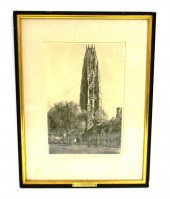 Louis Orr (American 1879-1961)
Louis Orr (American 1879-1961) ''Harkness Tower '' etching of Yale University campus landmark c.1920s matted and framed under glass part of limited edition series given to those who served Yale's Program for the Arts and Sciences between 1960-1962 typewritten note verso ss: 10 1/2'' h. x 7'' w.
Louis Orr (American 1879-1961)
Louis Orr (American 1879-1961) ''Harkness Tower '' etching of Yale University campus landmark c.1920s matted and framed under glass part of limited edition series given to those who served Yale's Program for the Arts and Sciences between 1960-1962 typewritten note verso ss: 10 1/2'' h. x 7'' w. -
 BONNIE MARRIS (MICHIGAN, BORN 1951)
BONNIE MARRIS (MICHIGAN, BORN 1951) TWO OFFSET LITHOGRAPHSBONNIE MARRIS (Michigan, born 1951) two offset lithographs: "New Beginnings," bison and a forest fire; elk and swans in winter. Both signed, edition 734/1000 and 268/1000, images measure 28.25" x 20" and 15" x 28", unframed. "New Beginnings" includes its original folio.
BONNIE MARRIS (MICHIGAN, BORN 1951)
BONNIE MARRIS (MICHIGAN, BORN 1951) TWO OFFSET LITHOGRAPHSBONNIE MARRIS (Michigan, born 1951) two offset lithographs: "New Beginnings," bison and a forest fire; elk and swans in winter. Both signed, edition 734/1000 and 268/1000, images measure 28.25" x 20" and 15" x 28", unframed. "New Beginnings" includes its original folio. -
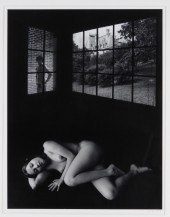 JERRY NORMAN UELSMANN SURREALIST
JERRY NORMAN UELSMANN SURREALIST NUDE PHOTOGRAPH Michigan,b.1934Untitled, 1979. Silver gelatin print of a recumbent nude woman in a darkened interior with a nude man seen peering through a window against a brick wall. A castle is seen in the distant background through a rainy window. Uelsmann is famed for his ability to work in darkroom effects creating surrealist imagery.
JERRY NORMAN UELSMANN SURREALIST
JERRY NORMAN UELSMANN SURREALIST NUDE PHOTOGRAPH Michigan,b.1934Untitled, 1979. Silver gelatin print of a recumbent nude woman in a darkened interior with a nude man seen peering through a window against a brick wall. A castle is seen in the distant background through a rainy window. Uelsmann is famed for his ability to work in darkroom effects creating surrealist imagery. -
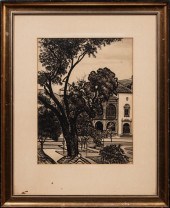 LOUISIANA SCHOOL, 1939Louisiana
LOUISIANA SCHOOL, 1939Louisiana School, 1939 , "Louisiana State University Campus View", ink wash on paper, indistinctly monogrammed and dated lower left, 20 3/4 in. x 15 1/8 in., framed, overall 32 3/4 in. x 26 3/4 in. x 1 3/4 in. Condition: Overall fair condition.
LOUISIANA SCHOOL, 1939Louisiana
LOUISIANA SCHOOL, 1939Louisiana School, 1939 , "Louisiana State University Campus View", ink wash on paper, indistinctly monogrammed and dated lower left, 20 3/4 in. x 15 1/8 in., framed, overall 32 3/4 in. x 26 3/4 in. x 1 3/4 in. Condition: Overall fair condition. -
 ALFRED
ALFRED EISENSTAEDT(German/America, 1898-1995) Drum Major and Children, University of Michigan, 1951, printed later (n.d.), signed recto lower right "Eisenstadt" and editioned 65/250, inscribed verso in pencil with Time Life Photo Lab information; "Print made in Time Life Photo Lab", gelatin silver print, image 16-1/2 x 21-1/4 in.; black and silver finished wood frame, 29-1/2 x 34-1/2 in. Provenance: Estate of Sally Kennedy, Asheville, North Carolina Condition: not examined out of frame, rippling at lower edge especially at lower center, print in otherwise good condition; frame with some wear especially at corners
ALFRED
ALFRED EISENSTAEDT(German/America, 1898-1995) Drum Major and Children, University of Michigan, 1951, printed later (n.d.), signed recto lower right "Eisenstadt" and editioned 65/250, inscribed verso in pencil with Time Life Photo Lab information; "Print made in Time Life Photo Lab", gelatin silver print, image 16-1/2 x 21-1/4 in.; black and silver finished wood frame, 29-1/2 x 34-1/2 in. Provenance: Estate of Sally Kennedy, Asheville, North Carolina Condition: not examined out of frame, rippling at lower edge especially at lower center, print in otherwise good condition; frame with some wear especially at corners
...many more examples with full details are available to our members - Learn more


